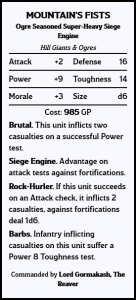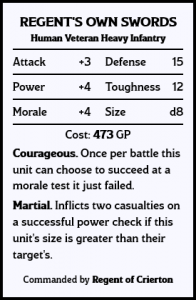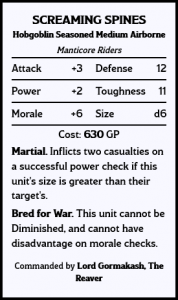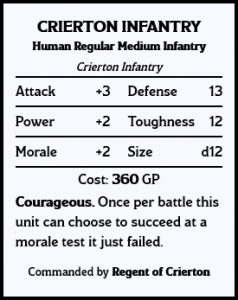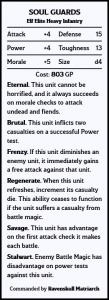End of Turn 6, the Battle for Ravenskull Valley
The battle rages on for the fate of Ravenskull Valley. In my previous post about MCDM’s “Strongholds & Followers” Warfare rules being used at scale, we had just reached the end of Round 3 when I reported in about how things were going.
We’ve now reached the end of Turn 6.
As a reminder, each round of S&F Warfare is 1 minute, or 10 rounds of D&D5e-scale “Encounter Battle” time under my house rules. So, the combined forces of the Human Castle-Town of Crierton and the Ravenskull Elves have been fighting the fearsome Sundered Mountain Legion of Hobgoblins for six minutes.
Using the “reaction / intercept” mechanic I introduced in my last blog post, the Heroes have attacked and defeated one of the two Seige Engine Units that the Hobgoblin army had, called “Mountain’s Fists”. It was a dangerous fight, which took most of a full night to resolve by itself via a standard D&D5e “Encounter Battle” mechanics. After all, they were attacking an army-scale unit capable of wrecking the walls of a castle.
Defeating this unit directly prevented the Siege Giants from potentially destroying the Gates, which would expose the Ravenskull to the risk of annihilation. Hobgoblins, of course, are notorious for attacking Elves first above all other targets, even more dangerous ones.
After a literal minute of rest, they then went over the wall once again to attack the leader of the Legion itself, the legendary “Gormakash, the Reaver”, via the encounter battle mechanics. The Heroes only narrowly defeated the Reaver. News of the Reaver’s defeat swept through the Legion forces, weakening their will to fight; all hobgoblin units immediately lost 1 point of size.
However, the infamous ferocity and stubborness of hobgoblin military prowess was proven again as two human units were driven from the field; the Regent’s own Swords, and the Crierton 1st Infantry Regiment. Additionally, the ongoing archery duel between the hobgoblins — including close air support — against the Clanhold Defenders resulted in one Elven unit being driven from the field.
Now, at the end of Turn six, the battered and exhausted Heroes are preparing to lead the thus-far in-reserve Ravenskull infantry out through the gates into the flank of the Legion. To do so, the Heroes are going to Intercept the last remaining group of Seige Giants and try to drive them from the field, to ensure that the gates cannot be brought down. If the Heroes fail, they have determined that the Crierton army will be forced to retreat in a few minutes, and the Elves will be unable to hold against the might of the Legion.
– – –
Mechanically, things are hanging in a good state of balance right now, which is prompting the players to take the risk of another Encounter Battle to firmly shove things the way they want. They have convinced the Ravenskull Matriarch (NPC) to take her infantry forces out of reserve and commit them to the battle. She is not keen on this, because it leaves only archers manning the walls to prevent a massacre of the civillians of the Clan, should the gates fall. However, due to prior adventuring, the group has a high reputation with her, so they can convince her. This places her and her Elite Heavy Infantry unit, known as the “Soul Guards”, on the battlefield as a potential target.
The loss of the Regent’s Own Swords is also of concern to the players, because it sets the stage for the death of the Regent of Crierton (NPC) himself. So far, the “Regent’s Own Lancers” are holding fast, but they have taken losses.
As I noted in the prior blog post there are three legendary NPCs on the field here, who are therefore part of the victory / loss conditions for the battle. They are the Reaver of the Legion, the Ravenskull Matriarch, and the Regent of Crierton. Each one can be killed in this battle, and doing so changes the long-term arc of the campaign, depending on who dies and who is left alive.
This is doing good things for narrative tension as the players try to juggle the desire to acheive an authorative win over the Hobgoblins against the risk to two well-liked NPCs and, indeed, the home of one of the characters. From my perspective, the “Reaction / Intercept” mechanic is providing a good amount of agency for the characters to directly affect the battle, but the cost in party resources is stiff enough to limit it.
The two human and one elven units that were destroyed in the past three rounds of combat were all death-spiraled. That is to say, they reached “Diminished” status, and then collapsed in the span of a single round. Given that a couple of these units were Size d12, the group were shocked at how fast they went from “just fine” to “off the board”.
By comparison, the Hobgoblin units, who cannot be “Diminished” due to the “Bred for War” racial ability, in some cases clung on stubbornly at a Size 1 for four rounds of concentrated attack. Notably, the Manticore Rider unit’s ability to apparently weave and dodge 11+ volleys of archery fire and still keep harrassing the Elves was approaching meme status when they finally were shot down.
There are two things which are beginning to stand out, mechanically, with the battle so far. The first is that “Bred for War” is likely under-valued by about 20%. The ability to simply ignore the routing mechanic is massive and has been a source of fustration to the players.
Secondly, is that we’re collectively wondering if we’ve hit the upper limit of feasible with S&FW. Obviously, the premise of the Warfare rules is to model battles between castle contingents; four or five units per side, likely battling under circumstances where massive maneuevers are not possible.
Here, however, the scope of the battle is making the system creak. We are modeling a clash between nation-states with 18+ unit cards per side. The unit engagement restrictions are creating circumstances where a single infantry unit is attacked six or eight times in a row, since the other side infantry units have nothing else to attack, and own-force risk-reduction is best achieved by “hounding” an enemy unit to destruction as opposed to scattering damage over a series of 1V1 engagements.
The last thing is a GMing note. I don’t want this to be a sterile card game, where the role-play of our game is lost to the wargame. So, I’ve been adding color with narrative snapshots — vingiettes of the battlefield — to “keep it costly” for the players. So far, the players seem to be staying in the right mind set. The narration of defeat of the 1st Regiment had one player PM me afterward; they felt that loss after the desperate last stand.
– – –
I expect we’ve probably got two more nights of play to resolve the Battle of Ravenskull Valley. Once the Heroes defeat the Seige Giants, I am pretty sure that short of Mean Dice, the Allied Forces will win now that the Ravenskull Elves are actively on the battlefield.
The only big question I have, as GM, is if the Matriarch will survive the battle. Given the Hobgoblin hatred of Elves, the first round that they Elves are fully commited to the battle, a significant amount of the might of the Legion is going to come to bear on the Ravenskull.
Narratively, the Matriarch is the mother of one of the Heroes, and the group as a whole has come to respect and appreciate the Matriarch as a person and leader. While the unit she is in, the “Soul Guards”, has the “Regenerate” ability, they are out-sized by several units who all have the “Martial” ability. The player’s attempt to save the Regent and the Crierton Army might well cost them another well-liked NPC.
I’ll update again at the end of the battle. In the mean time, I’d love to hear your thoughts about MCDM’s “Strongholds & Followers” Warfare rules, and if you have seen the “Bred for War” ability severely affect the outcome of the battle. How big have you gone with this system? Let me know in the comments below!
